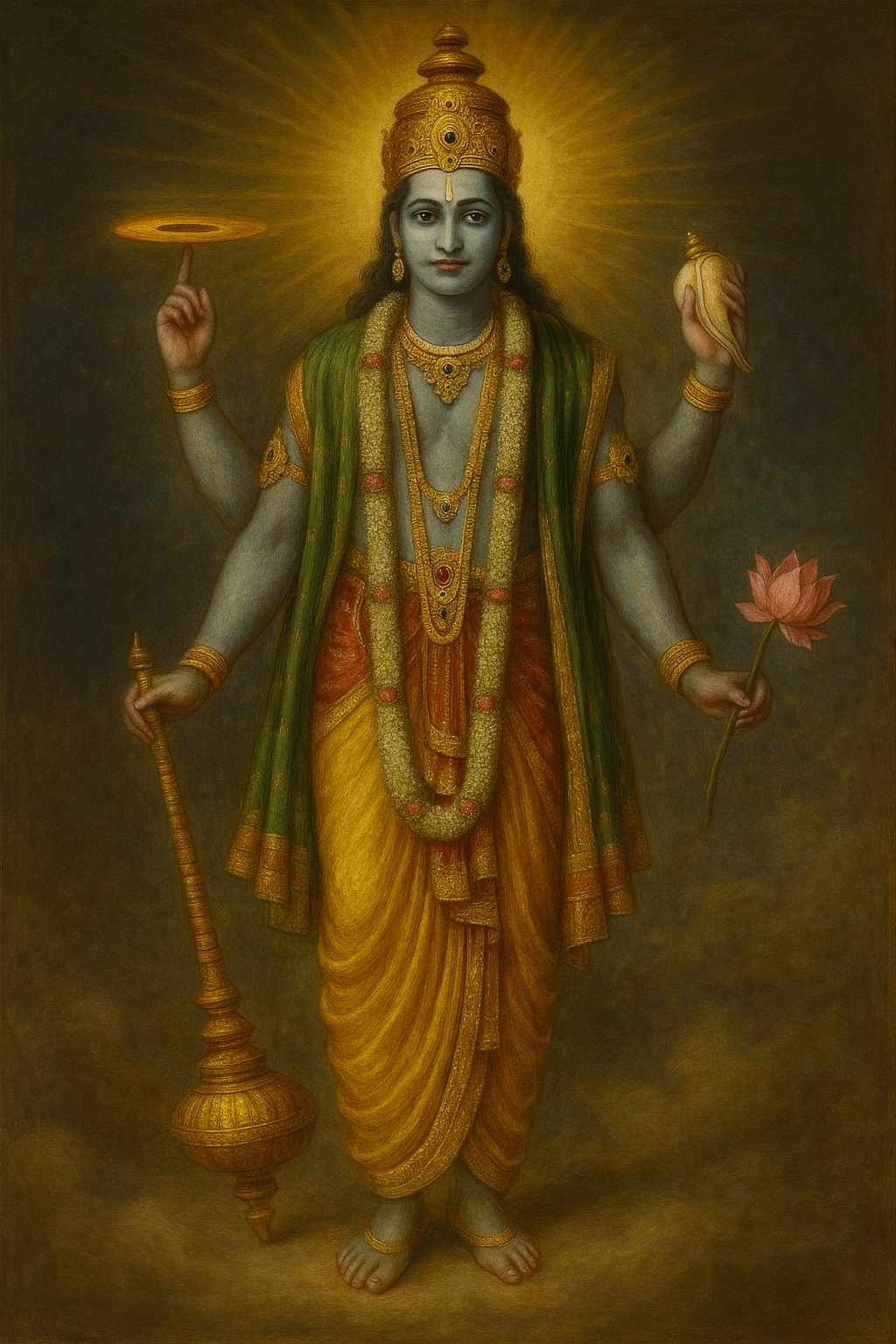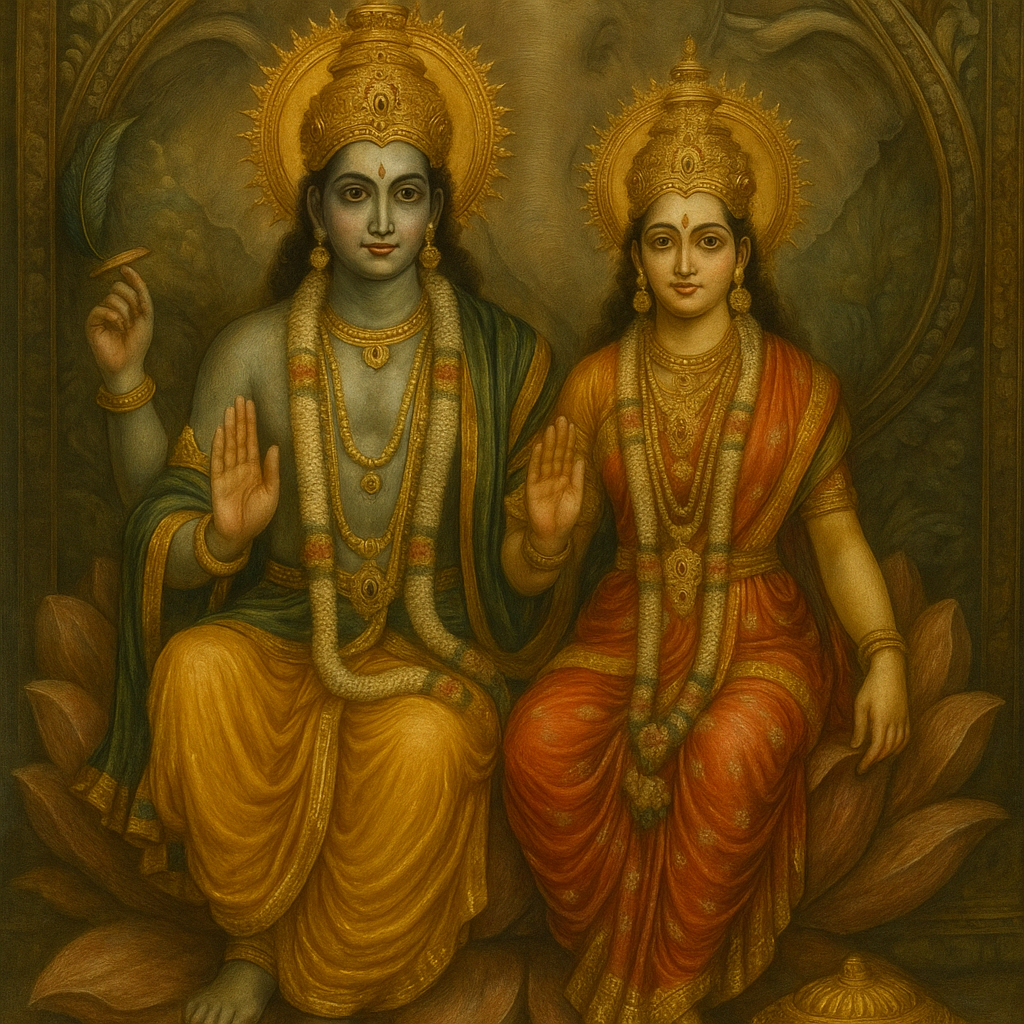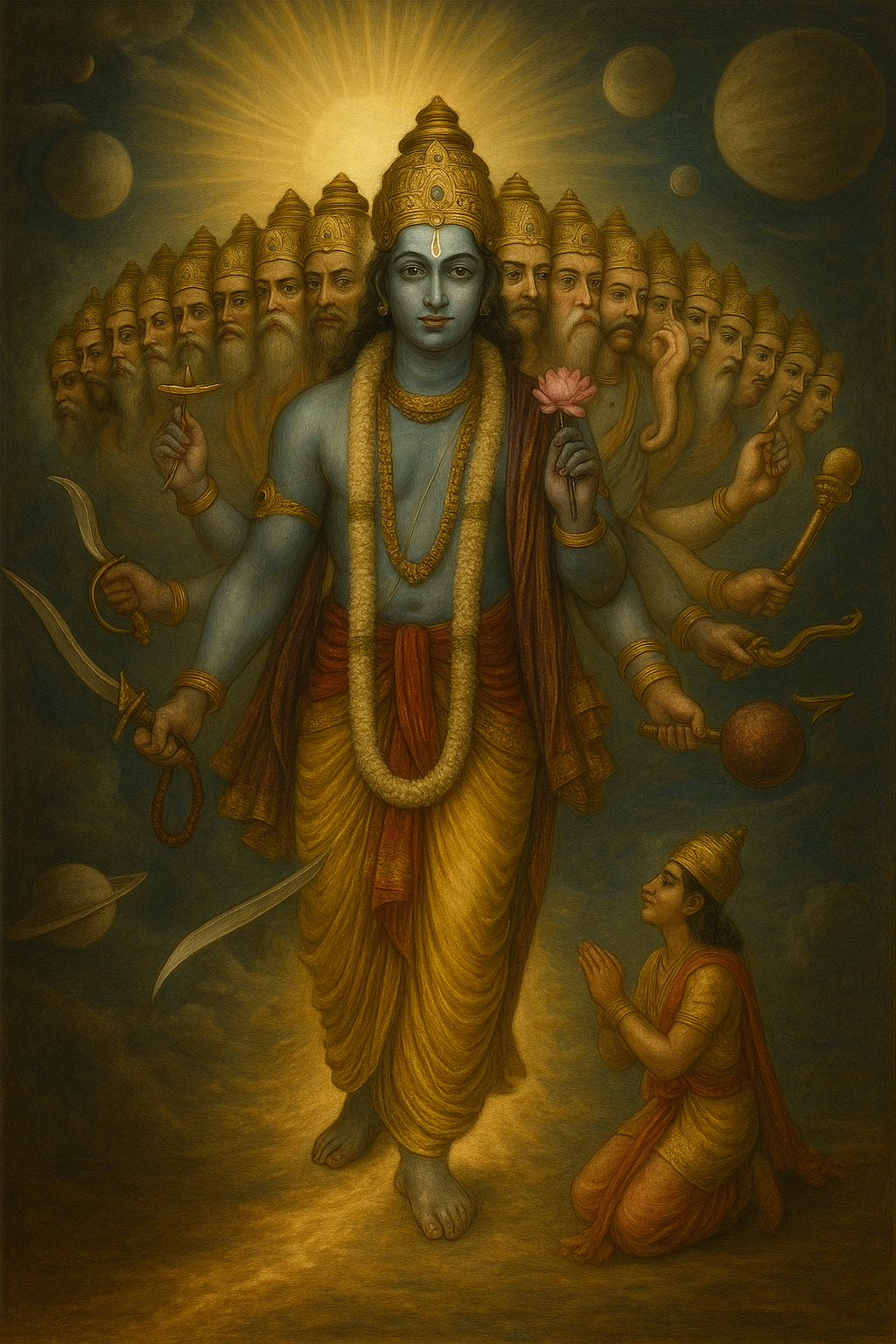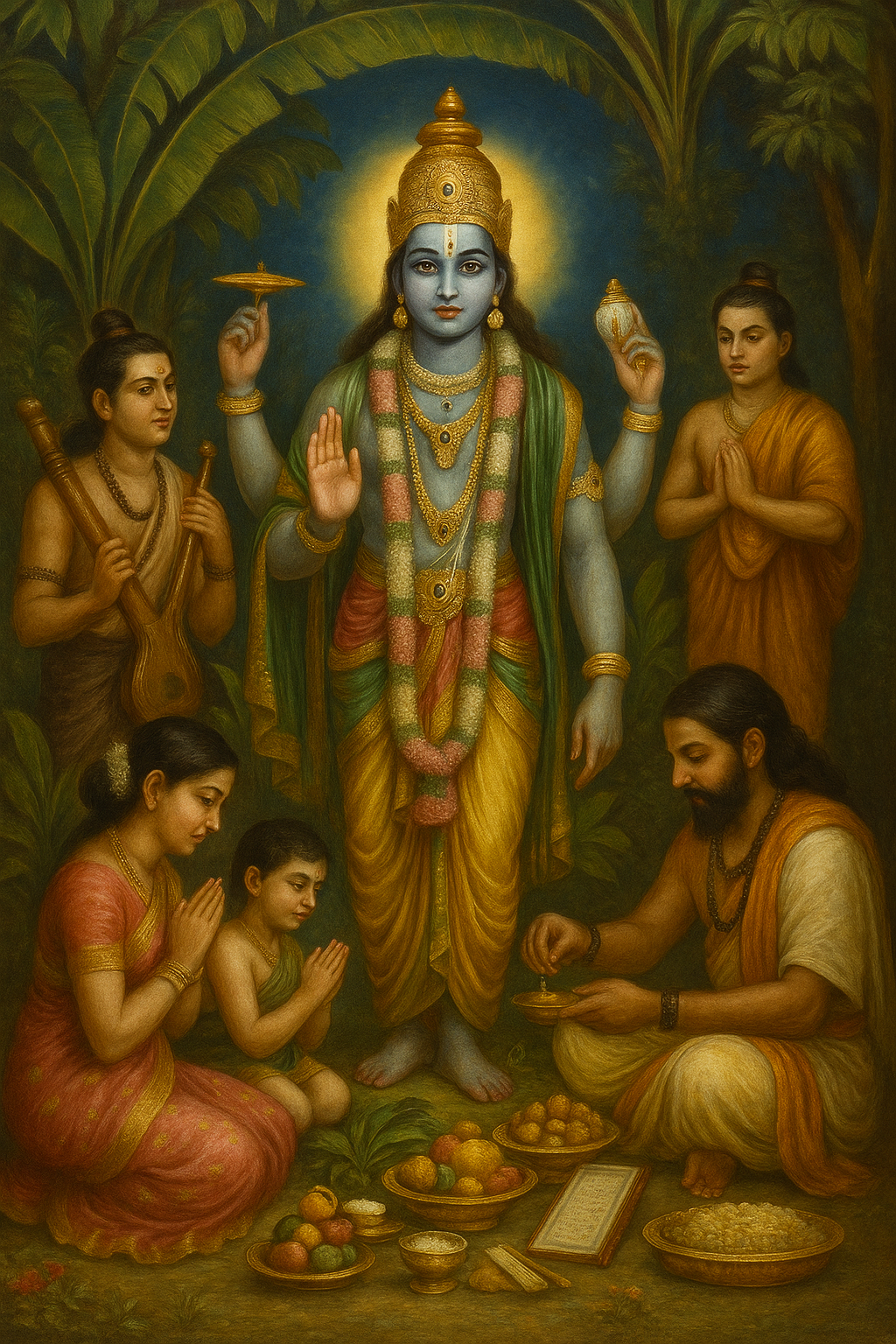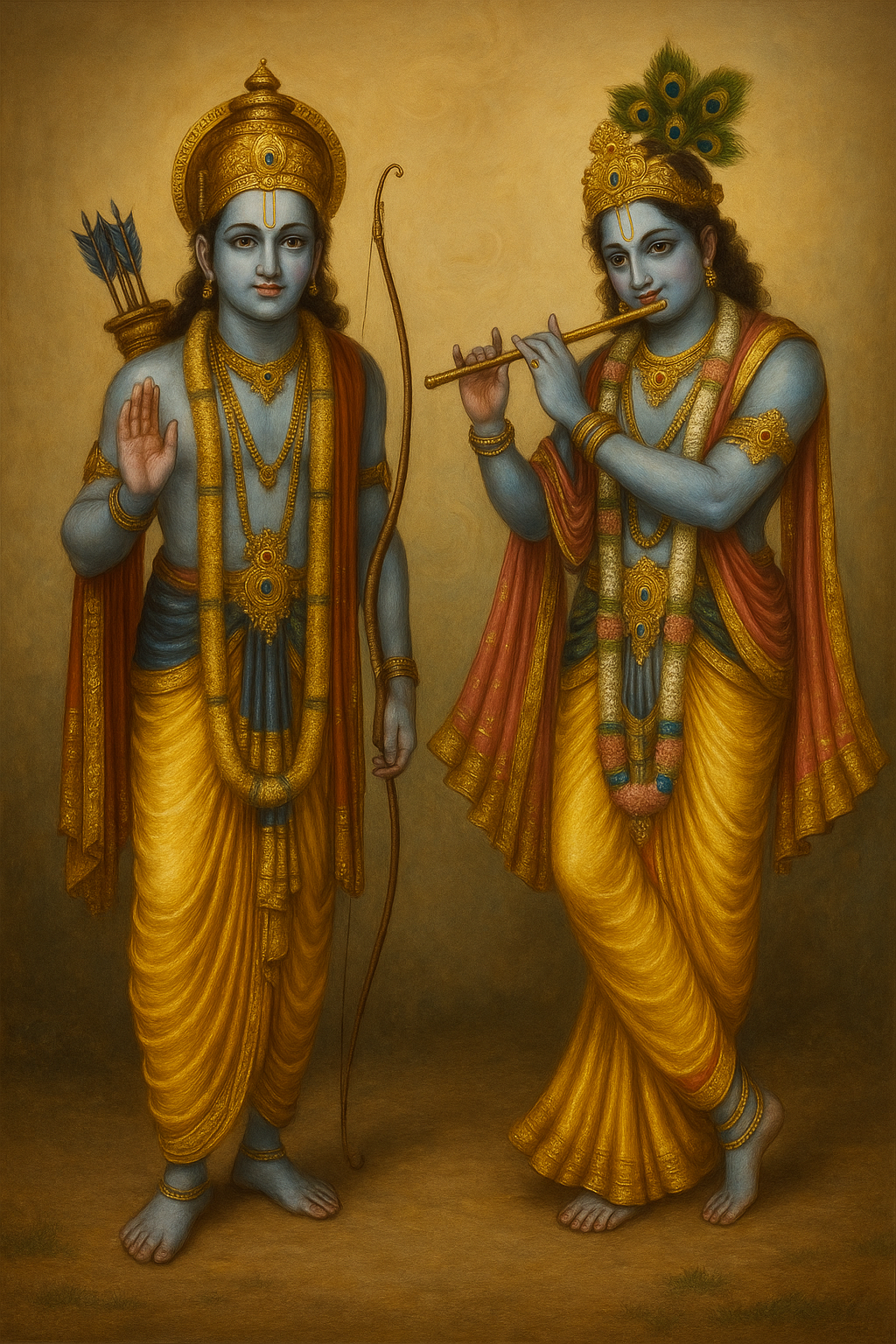Importance of Vishnu Sahasranam
The Vishnu Sahasranam, a revered Sanskrit hymn, extols the thousand and eight sacred names of Bhagwan Vishnu, the Supreme Being in Vaishnavism and one of the principal deities in Sanatan Dharma. It is widely regarded as one of the most sanctified stotras, prominently featured in the Anushasana Parva of the Mahabharata, occupying Chapter 149. The hymn comprises 142 shlokas, out of which 107 shlokas meticulously enumerate the thousand divine names of Bhagwan Vishnu, while the remaining verses serve as an invocation and conclusion.
This version from the Mahabharata is considered the most venerated among various interpretations, although alternate renditions also exist in the Padma Purana, Skanda Purana, and Garuda Purana. The Sahasranam is chanted with profound reverence across the length and breadth of Bharat, symbolizing both devotion and the pursuit of divine grace. Each of the thousand names glorifies a distinct attribute of Bhagwan, reflecting His infinite virtues and boundless majesty.
Sahasranams, as compositions, are hymns of exaltation, with "Sahasra" signifying 'thousand' and "Nam" meaning 'name.' These stotras are revered as sacred songs of praise, embodying the essence of devotion and surrender.
The chanting of mantras, shlokas, or stotras serves as a powerful means to align one's inner energies with the cosmic vibrations. Each syllable, when pronounced with precision, generates a palpable energy that resonates within, stimulating even the tiniest cells and neuro-centers of the body. Such is the profound effect of sacred utterances that they transcend mere words to become carriers of divine energy, purifying the mind and sanctifying the spirit.
Among these sacred hymns, the Vishnu Sahasranama holds a place of unparalleled reverence. It is considered the very essence and heart of the Mahabharata. Indeed, the great epic itself is often regarded as an elaborate commentary on this sacred hymn. The Sahasranama is presented in the context of Bhishma imparting the essence of Dharma to Yudhishthira, distilling the essence of the shastras into a thousand sacred names. These names were recalled by Vedavyasa, believed to be an incarnation of Bhagwan Vishnu, drawing from the utterances of illustrious rishis, like honey gathered from various flowers. Passed down through tradition, these names reveal an intrinsic connection, flowing seamlessly from one to the next, embodying divine attributes.
Each name within the Vishnu Sahasranama carries a profound meaning. This hymn is regarded as the very essence of the Vedas, reflecting the nature and glory of the Supreme Reality in its myriad aspects. It represents the path to realizing the highest goal of human life, spiritual liberation. The phonetic vibrations generated during the recitation of each Nama, and the collective chain known as Namavali, create subtle waves that are believed to awaken knowledge and wisdom within the devotee.
Scholars have long established the benefits of these sound vibrations for those who chant and those who listen. Reciting the Vishnu Sahasranama with devotion not only sharpens the mind but also harmonizes the brain’s neuron activity, emitting brain waves at optimal frequencies that resonate with divine energy. Through mindful chanting, one's thoughts are directed onto a path of purity and devotion, leading to spiritual elevation and inner peace. Thus, the Vishnu Sahasranama serves as a sacred bridge, connecting the devotee to the divine essence of Bhagwan Vishnu.
Kaliyuga and Mantras
In the sacred texts of Sanatan Dharma, Dharma is symbolically represented as a bull, signifying its strength and stability in different Yugas. In the age of Satya Yuga, the bull stands firmly on four legs, embodying complete righteousness. With the descent into Treta Yuga, Dharma weakens, and the bull is seen standing on three legs. In Dwapara Yuga, where Dharma and Adharma are in equilibrium, it balances precariously on two legs. Finally, in the present age of Kali Yuga, Adharma overwhelmingly surpasses Dharma, leaving the bull to teeter on a single leg, symbolizing the severe decline of virtue.
This degradation of Dharma is mirrored in the potency of Mantras and Stotras. The sacred chants, which once held immeasurable power in Satya Yuga, have witnessed a marked decline in their efficacy through successive ages. In Kali Yuga, many of these sacred utterances, once brimming with divine energy, are said to have lost much of their original potency.
Why Vishnu Sahasranam is an Exception?
The Vishnu Sahasranam stands apart from all other stotras and mantras due to the extraordinary circumstances of its revelation. Its setting unfolds during the final days of the Mahabharata war, as Bhishma, the venerable scion of the Kuru dynasty, lay upon a bed of arrows. Despite his mortal wounds, Bhishma, a devout devotee of Shri Krishna, received visits from kings and kin every evening. Among the visitors was Yudhishthira, the embodiment of Dharma, who sought Bhishma's wisdom on statecraft, warfare, and governance.
One evening, Yudhishthira, burdened by the weight of future uncertainties, inquired who would be the eternal refuge for the world in the dark age of Kali Yuga, when Adharma would reign supreme. Bhishma, with unwavering devotion, turned to Shri Krishna, who stood beside Yudhishthira, embodying the very essence of Mahavishnu. At that moment, Shri Krishna nodded, granting Bhishma the divine permission to impart the sacred *Vishnu Sahasranam* to Yudhishthira.
This event is unparalleled in the history of stotra creation. Yudhishthira, the very personification of Dharma, posed the question; Bhishma, the Vasu and son of Ganga, delivered the answer; and Shri Krishna, the Supreme Being himself, bore witness, affirming the sanctity and potency of the hymn. Further, it was immortalized by Bhagwan Vyasa, an incarnation of Vishnu, and inscribed by Bhagwan Ganesh.
No other stotra has ever been revealed under such divine confluence. The physical presence of Shri Krishna during its recitation ensures that the *Vishnu Sahasranam* remains unblemished by the shifts in Dharma across Yugas, preserving its sanctity and potency through the ages.
The Science of Vishnu Sahasranam
The Vishnu Sahasranama, a profound and sacred hymn, is revered as the very essence of the Vedas. Each name of Bhagwan Vishnu contained within the Sahasranama is imbued with deep significance, representing a divine attribute or a facet of His boundless glory. These thousand names, collectively known as Namavali, are not mere appellations; they are expressions of the Ultimate Reality in its various manifestations. To chant these sacred names is to invoke the very essence of divinity, drawing oneself closer to the supreme consciousness that pervades all existence.
The recitation of the Namavali is rooted in the science of sound vibrations. When each Nama is uttered with devotion and clarity, it produces a unique vibrational frequency that resonates through the body and mind. Scholars have long emphasized the transformative power of these sound waves, noting how they stimulate neural pathways, enhance mental clarity, and elevate spiritual awareness. This sacred vibrational energy not only purifies the individual but also aligns the mind with cosmic rhythms, fostering an inner harmony that transcends worldly distractions.
The benefits of chanting the Vishnu Sahasranama extend beyond the spiritual realm. Modern science has begun to acknowledge the impact of vibrational frequencies on the brain's neural networks. Reciting the divine names of Bhagwan Vishnu strengthens these neural pathways, enhancing memory, concentration, and emotional stability. Furthermore, the brain emits waves at optimal frequencies during chanting, allowing the divine energies of Bhagwan Vishnu to resonate deeply within the devotee's being. This harmonious alignment purifies thoughts, dispels negativity, and nurtures a serene and balanced state of mind.
Ancient Siddhars, seers of profound wisdom, spoke of the seventy-two thousand nadis, subtle energy channels, that course through the human body. Each of these nadis is believed to carry life force, or prana, to every cell, sustaining vitality and consciousness. In the context of the Vishnu Sahasranama, every divine name corresponds to a verse of the Brihati Sahasra, a part of the Vedas containing thirty-six syllables. These syllables are further divided into swaras (vowels) and vyanjanas (consonants), creating a total of one thousand mantras. This configuration mirrors the complete human lifespan of one hundred years, symbolized by thirty-six thousand days and nights, each linked to the nadis that sustain life.
The recitation of the Vishnu Sahasranama purifies these energy pathways, cleansing the nadis and invigorating the physical and spiritual body. This purification facilitates the mind's elevation, reprogramming neural transmitters to vibrate at frequencies aligned with divine consciousness. Thus, the very act of chanting becomes an exercise in spiritual refinement, awakening the inner self to the supreme reality of Bhagwan Vishnu.
In his commentary on the Vishnu Sahasranama, Adi Shankaracharya extolled the practice of chanting the divine names as a potent yet effortless means of attaining the fourfold goals of life: Dharma (virtue), Artha (wealth), Kama (pleasure), and Moksha (liberation). He emphasized that this sacred practice, unlike many other forms of spiritual discipline, is marked by non-violence (ahimsa) and does not demand elaborate rituals, specific locations, or strict observances of time. The path to divine communion is laid open, accessible to all who approach it with sincere devotion and purity of heart.
Bhishma, lying upon a bed of arrows, imparted this sacred hymn to Yudhishthira in the presence of Shri Krishna Himself, affirming its divine authority. Bhishma declared it as the highest form of Dharma, a path that transcends the constraints of age and circumstance. Adi Shankaracharya, too, in his hymn, expressed a singular longing, not for wealth, fortune, or even liberation, but merely for the grace to chant the holy names of Bhagwan Vishnu until his last breath.
The significance of this sacred hymn was further acknowledged by Parashara Bhattar, who in his commentary proclaimed the Vishnu Sahasranama to be a sovereign remedy for worldly afflictions. He, like Shankaracharya, viewed the stotra as possessing the same divine authority as the Bhagavad Gita, serving not only as a source of solace but as a guide towards spiritual liberation.
At the culmination of the Vishnu Sahasranama, Bhagwan Vyasa, the great sage who immortalized it in the Mahabharata, affirms its divine potency by guaranteeing its practitioners all the blessings they seek. The act of chanting, therefore, is not a mere ritual but a sacred journey towards divine communion, a path that cleanses the soul, purifies the mind, and brings one closer to the eternal grace of Bhagwan Vishnu. In this lies the true merit of the Vishnu Sahasranama, an eternal beacon of spiritual light in the ever-changing tides of time.

